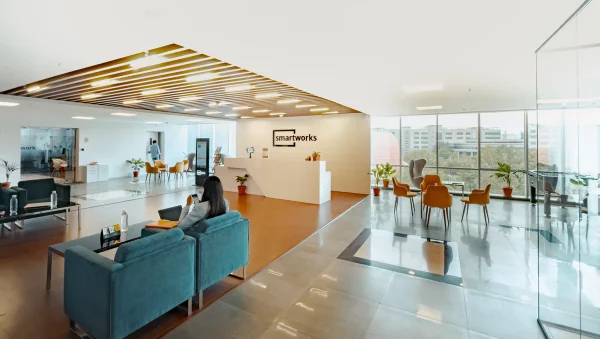
Wayfinding is the name given to the communication of information people need to navigate from one part of a physical space to another part. When Wayfinding is working well it means:
• you know where you are
• you know where you want to be
• you have an effective route to your destination
• you easily recognise your destination when you reach it
• and you know how to find your way back
A Wayfinding Fail
Imagine it is Sunday, and you need to visit the maternity unit at a large hospital. The maternity unit has extensive car parking facilities, so you decide to travel by car. On arrival, you follow clear signs that take you round to the parking spaces outside the maternity unit, located in an annex to the main hospital building. With flowers in hand, you make the short walk from your car to the entrance to the maternity unit. But you are greeted by a sign informing you that this entrance is only in use Monday to Saturday and that on Sundays the maternity unit is accessed from the hospital’s main entrance.
This is a wayfinding fail. Although information regarding the hours/days that the maternity unit’s entrance is available to the public is clear and available, it is not positioned at an appropriate decision point: maternity unit visitors need to be made aware of the unavailability of the maternity unit entrance on Sundays before they decide where to park (ie closer to the main entrance of the hospital or closer to the maternity unit entrance).
However, the wayfinding failure may not be the fault of the original wayfinding designers. It may be the case that when the maternity unit first opened, dedicated reception staff were on duty seven days a week, but budget cuts made some time afterwards necessitated a reduction in staff hours. Therefore, the effectiveness of the hospital’s wayfinding was reduced by an operational change.
Or it may be the case that additional signage was added at an appropriate decision point, but it is obscured by an overgrown hedge or tree, or perhaps the sign has been damaged and needs to be repaired or replaced. This would make the wayfinding fail a hospital grounds maintenance issue.
How technology is changing Wayfinding
Digital navigation is easier and quicker to update than traditional physical signage. Global positioning systems are part of everyday life. Millions of people and vehicles are guided down roads and pavements every day by reliable digital navigation. It is an obvious next step to take this digital navigation indoors, enabling patients and other visitors to navigate from outside the hospital all the way to the specific location they need—whether that is a bed on a ward, a consulting room, the café, or the pharmacy—and adding much more value. Essentially technology can create a sat-nav for indoors, not just outside. But unlike car sat-nav, the system is accurate to 1-2 metres as the ‘sensors’ are within the hospital (not 12,000 miles away in space).
One example is the BuzzStreets Wayfinding system, already being trialled in a number of hospitals including the Chelsea and Westminster in London. BuzzStreets helps visitors navigate through the hospital providing a more independent experience as the navigation app can personalise the route: the app can choose the fastest or the least busy route; if you want/need to avoid stairs, the app will show you how; it can even highlight interesting features (such as art on the corridor walls) along the way.
Wayfinding helps staff too
Digital indoor navigation could also be a boon to staff. Research involving UK teaching hospitals looking at doctors’ expectations and experiences noted that many participants mentioned getting lost and reported that, particularly when working on large sites, route optimisation was a vital part of task prioritisation, and that this was most important during crash calls. These are situations where staff are under time pressure and may be called to a ward that they have not been to before. Almost half of participants reported becoming lost on the way to a crash call.
One participant said: “Crash calls are often slowed when you don’t know where it is. Ward names can give no indication of where they are. Even registrars get lost sometimes.” (Source: British Medical Journal)
More than just A to B
The advantage of indoor navigation apps is that the system can be much more than a reliable way to move from A to B. Other services—such as appointments, examination results, general hospital information, spaces available in the parking areas—can also be incorporated into a single mobile application. For example, BuzzStreets includes features such as a communication system between patient and doctor, the possibility of scheduling appointments, receiving medical scans and prescriptions in the app, heat maps, contextual notification, updated and edited locations, appointment reminders, and multilingual voice guidance.
Tracking equipment
Digital Wayfinding systems can allow staff to trace equipment that is regularly moved around a hospital (e.g. wheelchairs) thus avoiding time wasted searching for them, or considering an item lost as no one knows where it is, and so a new one is ordered. Again, a saving of both time and money.
Conclusion
Whether it is by reducing staff distraction or by helping management introduce efficient practices, there are many ways and means for hospitals and patients to save time and money with a digital location and navigation system.
ABOUT THE AUTHOR:
Joe Fernandes, founder and CEO of BuzzStreets, an award-winning navigation platform, that enables organisations (hospitals, shopping malls, airports, offices, stadiums, etc.) to offer their customers an indoor way-finder that allows them to navigate inside the building. The client arrives at the entrance or reception and then uses the bespoke app to navigate to the specific location (room, shop, check-in, office, or even seat) they need. BuzzStreets also supplies movement analytics that can help improve building efficiency and keep track of vital equipment.
